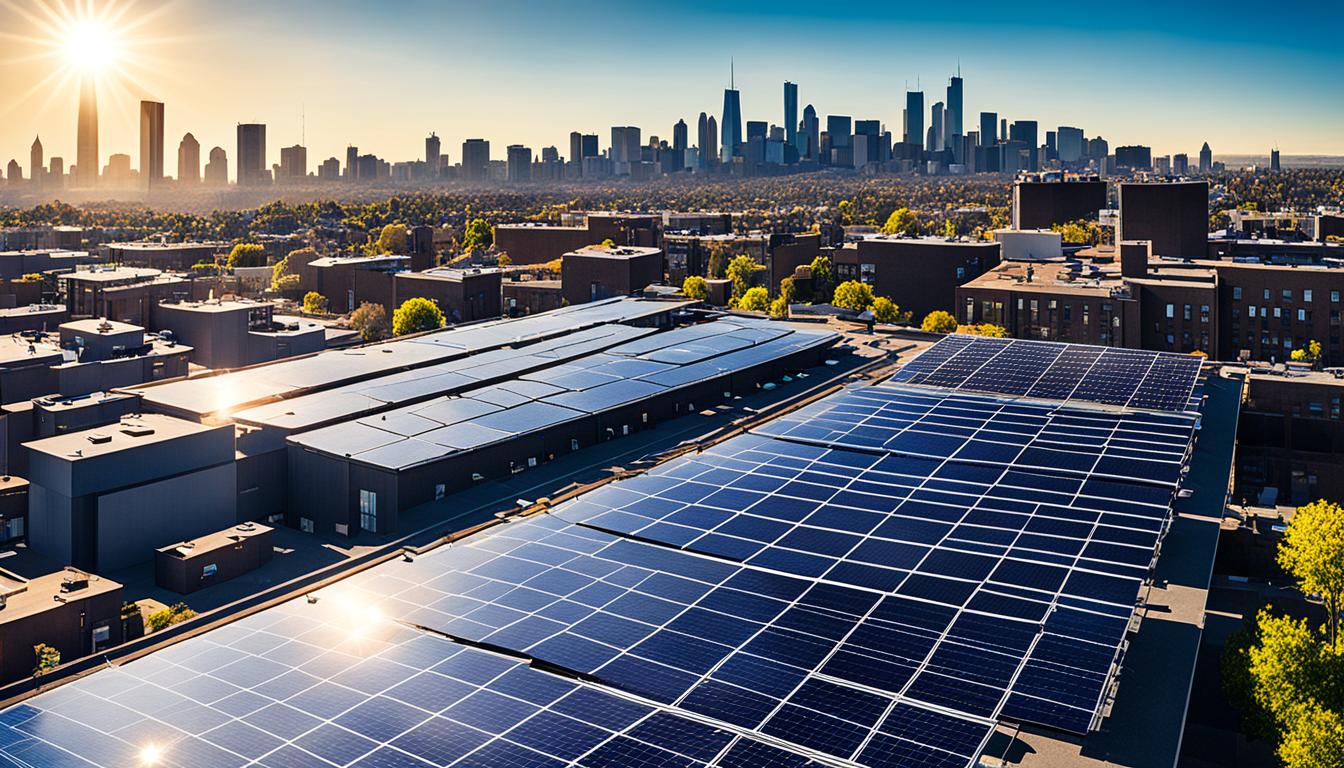
A global shift towards clean energy is underway, with countries around the world increasingly turning to solar power as a sustainable and renewable energy source. Solar energy offers a multitude of benefits, making it an attractive option for nations looking to reduce their carbon footprint and combat climate change.
In this article, I will explore the growing adoption of solar energy in various countries and highlight the impact it is having on the global energy landscape. From leading countries in solar energy adoption to the future outlook of this renewable source, we will delve into key aspects of the solar revolution.
Key Takeaways:
- Solar energy is being embraced by countries worldwide as a sustainable and renewable energy source.
- Germany, China, the United States, India, and Japan are among the leading countries in solar energy adoption.
- The benefits of solar energy include reducing greenhouse gas emissions and providing a renewable energy source.
- The future outlook for solar energy is promising, with advancements in technology and declining costs.
- Solar power is expected to play a pivotal role in achieving a sustainable and carbon-neutral future.
Leading Countries in Solar Energy Adoption
Several countries are leading the way in solar energy adoption, demonstrating their commitment to clean and sustainable energy sources. These countries have made significant investments in solar power infrastructure and have implemented supportive policies to accelerate the transition towards renewable energy.
Germany is a trailblazer in solar energy, renowned for its robust feed-in tariff system and ambitious renewable energy targets. The country has successfully harnessed the power of the sun, positioning itself as a global leader in solar technology.
China, the world’s largest emitter of greenhouse gases, has made substantial strides in solar energy adoption in recent years. Through extensive government support and incentives, China aims to become a dominant player in the clean energy sector, revolutionizing the global energy landscape.
The United States has also emerged as a key player in solar energy adoption. With vast expanses of land and a favorable regulatory environment, the country has witnessed a rapid increase in solar capacity. The commitment of both federal and state governments to renewable energy has further bolstered the growth of solar power in the United States.
India is another notable country leading the charge in solar energy adoption. The Indian government has set ambitious renewable energy targets, aiming to achieve 40% of its energy mix from non-fossil fuel sources by 2030. This commitment has spurred the development of large-scale solar projects across the country.
Japan has also made significant investments in solar power infrastructure, capitalizing on its high energy demand and limited domestic fossil fuel resources. The country’s favorable solar policies and supportive regulatory framework have propelled Japan to the forefront of solar energy adoption in Asia.

Solar Energy Adoption Comparison
| Country | Installed Capacity | Government Support |
|---|---|---|
| Germany | 40 GW+ | Robust feed-in tariff system, ambitious renewable energy targets |
| China | 250 GW+ | Extensive government support, incentives, and subsidies |
| United States | 100 GW+ | Federal and state support, favorable regulatory environment |
| India | 40 GW+ | Ambitious renewable energy targets, government incentives |
| Japan | 60 GW+ | Favorable solar policies, supportive regulatory framework |
Benefits and Future Outlook of Solar Energy
The adoption of solar energy brings numerous benefits, both for the environment and for countries’ economies. Solar power helps reduce greenhouse gas emissions, mitigating the effects of climate change. By harnessing the energy from the sun, solar power offers a clean and sustainable alternative to fossil fuels, reducing reliance on non-renewable energy sources.
One of the key advantages of solar energy is its ability to generate electricity without producing harmful emissions. Unlike traditional power plants that burn fossil fuels, solar panels convert sunlight directly into electricity, resulting in a significant reduction in carbon dioxide and other pollutants. This clean energy source plays a crucial role in mitigating the effects of climate change and creating a more sustainable future.
Furthermore, the future outlook for solar energy is promising. Rapid advancements in technology have led to increased efficiency and affordability of solar panels. The declining costs of solar energy installations, combined with various government incentives and subsidies, are making solar power an increasingly viable and competitive energy option. As a result, more and more countries are investing in solar power infrastructure as part of their clean energy transition plans.
In conclusion, the numerous benefits of solar energy, such as reduced greenhouse gas emissions and a renewable energy source, make it a crucial player in the global shift towards clean energy. With continued advancements in technology and increasing support from governments, solar power is poised to play a pivotal role in achieving a sustainable and carbon-neutral future.
FAQ
How does solar energy work?
Solar energy is generated through the use of photovoltaic (PV) cells, which convert sunlight into electricity. These cells are typically made up of silicon and other materials that have semiconducting properties. When sunlight hits the cells, it excites the electrons, causing them to move and generate an electric current. This current is then captured and converted into usable electricity.
What are the advantages of using solar energy?
Solar energy offers several advantages. Firstly, it is a renewable and sustainable energy source, as sunlight is abundant and will not run out. Secondly, solar power helps reduce greenhouse gas emissions, as it produces clean electricity without burning fossil fuels. Additionally, solar energy systems can be installed on rooftops or in remote locations, making it accessible to a wide range of individuals and communities.
Will my solar panels work on cloudy days?
Yes, solar panels still generate electricity on cloudy days, although at a reduced efficiency compared to sunny days. While direct sunlight produces the most electricity, solar panels can still capture diffuse sunlight and convert it into usable power. The efficiency of solar panels can also be improved with advancements in technology, allowing them to generate more electricity even in low-light conditions.
How long do solar panels last?
Solar panels are designed to be durable and long-lasting, with most manufacturers offering warranties of 25 years or more. The actual lifespan of solar panels can vary depending on factors such as their quality, maintenance, and environmental conditions. However, it is not uncommon for solar panels to continue operating effectively for 30 years or more.
Can I sell excess solar energy back to the grid?
Yes, in many countries, it is possible to sell excess solar energy back to the grid through a process known as net metering or feed-in tariffs. This allows homeowners and businesses with solar panels to earn credits or receive payment for the electricity they generate and do not use. It is a way to further incentivize the adoption of solar energy and promote the generation of clean electricity.
Source Links
- https://finance.yahoo.com/news/enphase-energy-applauds-dutch-senate-210500497.html
- https://jg-tc.com/news/state-and-regional/pacers-and-indianapolis-use-3-year-delay-to-add-new-wrinkles-to-1st-nba-all/article_5724f689-4a6e-5b84-b09b-156ff5b49344.html
- https://www.ademcetinkaya.com/2024/02/whats-buzz-behind-dev-stock.html








